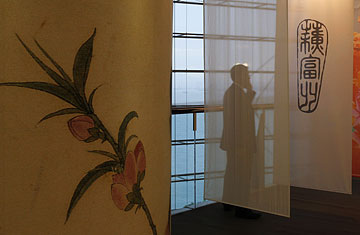
A visitor talks on a mobile phone at a preview show of Sotheby's Autumn Sales 2008 at the Hong Kong Convention and Exhibition Centre on Oct. 3
Responding to turmoil in the global financial sector, Asian art collectors also proceeded with caution this week, sending the hot market for contemporary Chinese art towards an apparent cool down. At a Sotheby's sale of 20th century Chinese artwork on Oct. 5, two-thirds of the 110 lots failed to sell, and many of the pieces that did find buyers went for below their estimated prices. By the close of the biannual sales of the world's largest publicly traded art auction house, Sotheby's took in about half what it had expected, at just over $140.7 million.
The lack of enthusiasm was not reflected in the auction rooms, which were well attended over the weekend with collectors from throughout the region, including Singapore, China and Indonesia. But Zhao Wuji's "7 Aout 2000" sold for $543,156 — over $44,000 short of Sotheby's low-end estimate of $587,500 — and several pieces, including paintings by star contemporary Chinese artists Zhang Xiaogang and Yue Minjun, went unsold at the modern and contemporary Asian art sale on Oct. 4. Many say the unimpressive results were a combination of already overinflated price estimates and the dismal economy. "Particularly with the fund managers, if they are concerned with things happening in the world, they may be inclined to hold on to their funds," says Mark Joyce, owner of Koru Contemporary Art in Hong Kong.
That's not good news for Sotheby's. Following the poor sales, the auction house's shares fell 14% on Oct. 6, hitting a three-year low. (Sotheby's was not available for comment.) Nor does it bode well for the regional art market: the Hong Kong auction was its first gauge after the worldwide financial crisis hit last month. "Due to uncertainty in the markets, investors are making selective choices as to where to spend their money," says Shirley Ben Bashat, director of the Opera Gallery Hong Kong.
Those choices do not seem to include any slowdown in snapping up the work of rising Southeast Asian artists, however. The Sotheby's auction for modern and contemporary Southeast Asian paintings on Oct. 6 had better sales, with I Nyoman Masriadi's "The Man from Bantul (The Final Round)" selling for $1,006,356 — a record price for both Southeast Asian contemporary art and the Indonesian artist. While Chinese contemporary art is looking like it may be heading for a slowdown, Bashat says, "Southeast Asian art still has appeal in this sense: good value art at reasonable prices, and artists that are yet to be discovered and are emerging at this time."
Beijing-based artist Zhao Gang isn't surprised. "Three years ago the prices started going higher and higher," says Zhao. "Last year the price was pushed way too high, and it's got to come down." In 2006, a collection of dreamlike portraits and landscapes by Zhang brought in just over $24 million — more than British art phenom Damien Hirst made in all of 2006. At Sotheby's Oct. 4 auction, the highest selling painting was Zhang Xiaogang's "Bloodline: Big Family No. 1," which sold for just under $3 million. In May, at rival auction house Christie's, a diptych of eight masked youths by Zeng Fanzhi fetched $9.7 million, a record for Asian contemporary artwork.
Still, the local art world isnt' getting too depressed — yet. Says Bashat, the director of the Opera Gallery Hong Kong, "Many buyers see art as a safer investment in the mid to long term compared to other investments in the market." Buyers may be turning away from contemporary Chinese art today, but at least they are keeping an eye on Asia.
